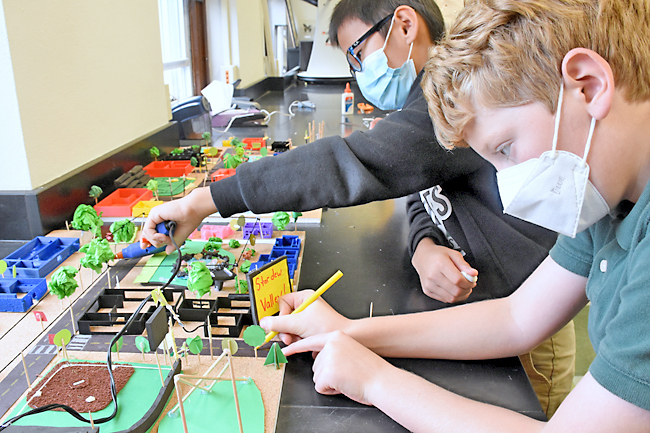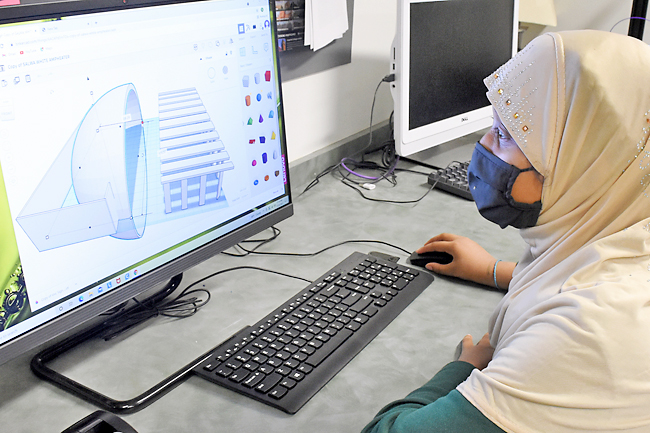Ann Cameron Siegal
THE WASHINGTON POST – As Alexandria Country Day School’s sixth-graders created miniature 3D printed villages to address homelessness, they learned lessons far beyond technology.
“It Takes a Village” began as a project for a science class – inspired by life-size 3-D printed homes built by Austin, Texas-based technology company Icon, whose mission is to make dignified, affordable housing available to everyone.
No strangers to classroom 3D projects, the students were fascinated by Icon’s use of a similar process to create homes made of inexpensive concrete-like material. Unlike standard construction methods, the process of building interior and exterior walls of these durable homes takes just a few days.
While creating their mini 3-D buildings, the students explored how such technology allows design freedom and quick changes. Mathematical conversions helped get the proportions right. For example, a real 25-foot-by-20-foot one-bedroom house would be printed as 40-millimetre-by-32-millimetre for their mini village.
Salwa Seman, 11, said that getting the dimensions and settings correct before construction began was challenging as she created a curved-wall amphitheatre.


“If the temperature of the printer is too hot or cold, or if the printed walls are too thin, the structures might fail,” she said.
“You learn from your mistakes and make adjustments,” said classmate Zoe Mandel, 11.
The tech-focused project quickly evolved into “an exercise in empathy, innovation and collaboration designed to bring about lasting change,” said science teacher Alison McDonald.
“When most people think of helping the homeless, they think of food and clothing drives,” said Juliet Galicia, 11. While necessary, those are temporary fixes. Even housing by itself is not a complete solution.
In designing their leave-homelessness-behind neighbourhoods, priorities were shelter, food stores, schools, and health and religious centres.
But to build a sense of belonging and purpose, the miniature communities also emphasised areas for frequent interaction among residents.
“We wanted to include extras that would make it feel more like a real community,” said Luke Wazorko, 11.
A community garden, a place to raise chickens, an amphitheatre for shared events, bus stops for access to jobs, and infrastructure for WiFi and cellphones to help in job searches were important features to offer formerly homeless residents.
“They get it!” said Amber Fogarty, president of Mobile Loaves & Fishes, a non-profit organisation tackling homelessness in Austin, after learning about the sixth-graders’ project.
“The biggest cause of long-term homelessness is a catastrophic loss in family relationships,” she said. “Housing alone will never solve homelessness, but community will. People need a place where they are known, nurtured and loved.”
Mobile Loaves & Fishes’ creation, Community First Village, offers tiny homes, stationary recreational vehicles and a few 3D printed homes as affordable, permanent housing options to end chronic homelessness.
That community’s design and those created by the Alexandria sixth-graders emphasise walkability and interaction with others. Each incorporates ponds and green space on the edge of the community, for fishing and quiet moments, and “makerspaces” for creating products to sell.
Delighted with the students’ practical priorities, Fogarty noted that Community First also includes front porches on each of its housing styles to encourage daily connections between people.
Referring to such student projects, she said, “Imagine the possibilities. How can you use your brains and hearts to solve problems?”
FUTURE OF 3-D PRINTED HOUSES
Many companies around the world are experimenting with this technology.
So far, only interior and exterior walls are 3D printed. A team of three to four people complete that task using a computer app operated by a tablet or smartphone and monitoring the process. A nozzle squeezes out the concrete mix in a pre-programmed pattern, building up layers until a basic house structure is formed. Roofing, doors, windows and finishing still need carpenters, plumbers, electricians and painters.
Designs are adaptable to individual preferences.
Mobile Loaves and Fishes’ Amber Fogarty said, “It’s a journey of discovery. We don’t know what the future holds for this new technology, but we’re excited about the innovative possibilities.”







